| This plant can easily sneak up on you! It is a low growing plant and is often found alongside our paths in both sunny and shady areas. It is covered with tiny stinging hairs that you will not want to touch. You will know if you have brushed up against this plant because of an unpleasant and sharp stinging pain. Fortunately the discomfort is not too strong and will last only 15 to 20 minutes!
|

|
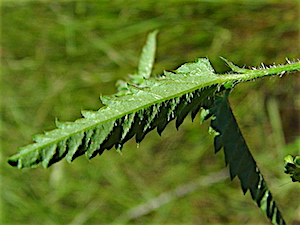
|
| |
Bristly Greenbriar
Smilax tamnoides
|
|
Amazingly enough, the greenbriars are a member of the Lily order! The catbriar and greenbriar are the only 2 vines in the park with both tendrils and thorns. The Bristly Greenbriar is easily distinguished from the more common greenbriar because its stems are covered with large numbers of both large and small thorns (prickles). The thorns on this vine are vicious and you should not try to pull the plant out with your hand. It is also very efficient at grabbing pants, shirts as well as bare skin if you brush up against it. Avoid touching this vine as the thorns easily break off under the skin and may requirea doctor to remove! It is usually seen as single vines and is not thicket forming.
|
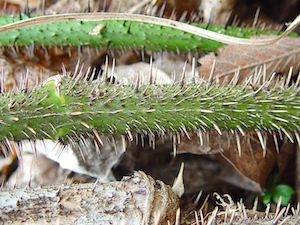
|
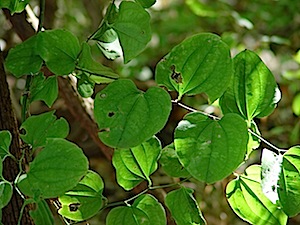
|
| |
Catbriar
Smilax bona-nox
|
|
The Catbriar is by far the most common green briar in the park. It is very easy to distinguish the Catbriar from the Bristly Greenbriar by its very tough, green and isolated triangular thorns growing on a rather smooth and sometimes square stem. It especially loves to grow in huge twisted thickets of vines. It also has distinctive mottled leaves often found with strong indentations. These vines and thorns can be very large and tough to break so it is best to go around them whenever possible. The tips of the young vines are animal friendly in that they are edible and also make a nice salad!
|
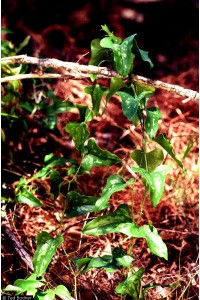
|

|
| |
Chinaberry
Melia azederach |
| This beautiful tree is very common in the park. It is very easy to distinguish from other plants by it dark green leaves, marble-sized berries, purple flowers and fairly smooth dark trunk covered with white horizontal dashes. Unfortunately the berries are very poisonous to nearly all animals and especially humans. The leaves and bark are also poisonous and so it is very insect unfriendly! The tree is weak because it usually has a center that is dead and so often is blown over by the wind. The leaves and berries change the soil so that other plants (even other chinaberries) have a difficult time growing there. |
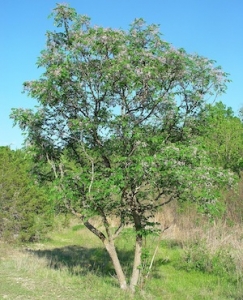
|

|
| |
Common Prickly-Pear Cactus
Opuntia macrorhiza
|
|
The common prickly pear has one of the most beautiful flowers of all of the cacti species found in the nature center. It is also one of the most dangerous plants around if you get off of the trail. Small plants effectively hide in the undergrowth and can easily puncture the sides of most shoes. Do not try to touch this plant because the smaller spines easily detach and will stay in your hand. Sitting or falling on one is also no fun at all (from personal experience) and so it is definitely not recommended. The pads and fruit on this cactus are edible but one has to remove all of the spines first. The Indians did this by burning them off using fire. The petals of the flowers may be used in a salad.
|
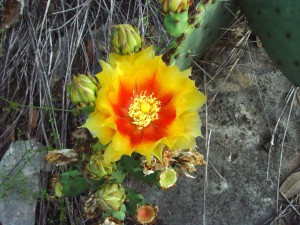
|

|
| |
Honey Mesquite
Prosopis glandulosa
|
|
Honey Mesquite can be dangerous as a small vine-like bush if you are walking along the trails. It is a very good ankle biter! As a tree it is very beautiful but one also has to watch out for the huge thorns on the limbs. The thorns are woody and very strong. They can cause major damage to anyone who accidentally runs into one of these! For nature lovers the mesquite, because of its thinner foliage is very friendly to plants growing underneath it and also to the many types of lichens growing harmlessly on its bark. The tree is a hardwood and is especially useful when smoking meats on the barbecue.
|
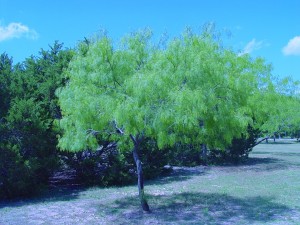
|
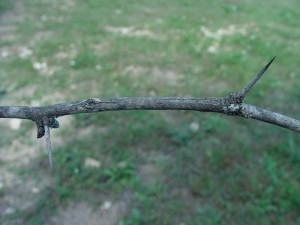
|
| |
Poison Ivy
Toxicodendron radicans ssp. verrucosum
|
| Poison Ivy is probably the most feared plant in the park. It has several forms and can appear as a woody plant or vine. Fortunately it is rather easy to recognize. The first thing to look for are the 3 leaves grouped at the tip of a vine. Second, the stem is usually red. Next, if you examine the leaves you will usually see a few that have side lobes. Finally, the leaves down the stem are paired, in other words side by side. All parts of the poison ivy plant should be avoided. Grape vines climbing up the side of a tree are often mistaken for poison ivy. Again, the poison ivy vines are very easy to pick out as they are covered with innumerable tiny hairlike rootlets as seen in the photo below. It is most often found in shady moist areas. It is interesting that this plant only affects people and is very beneficial to wildlife and insects!
|
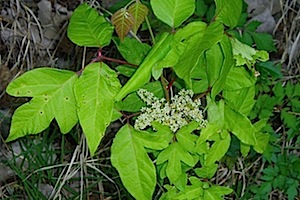
|

|
| |
Silver-Leaf Nightshade
Solanum elaeagnifolium
|
| The silver-leaf nightshade is one of the most common plants found along the paths in the nature center. It is easily recognizable by its purple flowers with prominent yellow centers and small pale-yellow fruit. It is in the same family as tomatoes and potatoes but do not eat the fruit as it is quite poisonous! In fact the entire plant is poisonous. Do not try to pull this plant out with your bare hands as the plant is covered with tiny needle-like nettles and it can be quite painful.
|

|
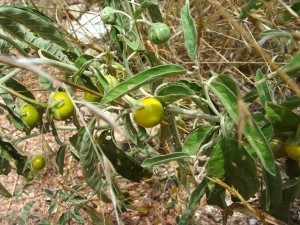
|
| |
Southern Dewberry
Rubus trivialis
|
|
These plants are very common in many parts of the park. They have wonderful berries in the spring and small white flowers. They also have numerous tiny sharp thorns and strong roots so it is not good to try to pull on one of these vines with ones bare hands. The stems often grow horizontally for many feet and so are easy to trip over! The are not very dangerous and mostly are difficult to walk through as they often form dense low tangles of plants. Forcing your way through these plants can result in the tiny thorns breaking off in your skin. They are generally fairly easy to pull out if done with care.
|
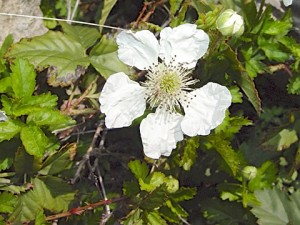
|
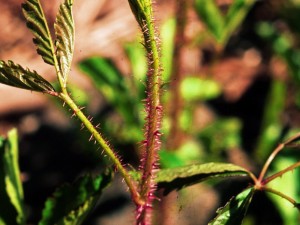
|
| |
Texas Bullnettle
Cnidoscolus texanus
|
|
These are plants that you really want to avoid! They are covered by nettles and touching them releases a very strong allergen. It is one of
the 2 most painful stings of any plant in the park. Even a slight brush up against this plant will often result in the needles penetrating your
blue jeans and can give you a nice sting. Sometimes it takes a while for the needles to work their way through your pants so you often do
not learn until later that you have encountered one of these plants. The pain can last from a few minutes up to a half hour. The stem, if
broken, will also release the allergen. So this is definitely a hands-off plant! You should gently wash the affected area with soap and water
as soon as possible to reduce the likelyhood of developing a rash from the allergens on your skin. The nettles do a fantastic job of warning
off animals that might want to eat the leaves or fruit. It has beautiful white flowers and grows to about 2 feet tall. It has edible fruits but it
is not recommended you try to extract them.
|
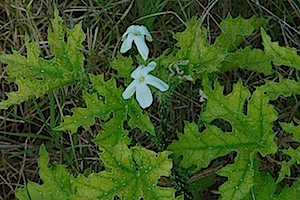
|

|
| |
More Galleries
|



















